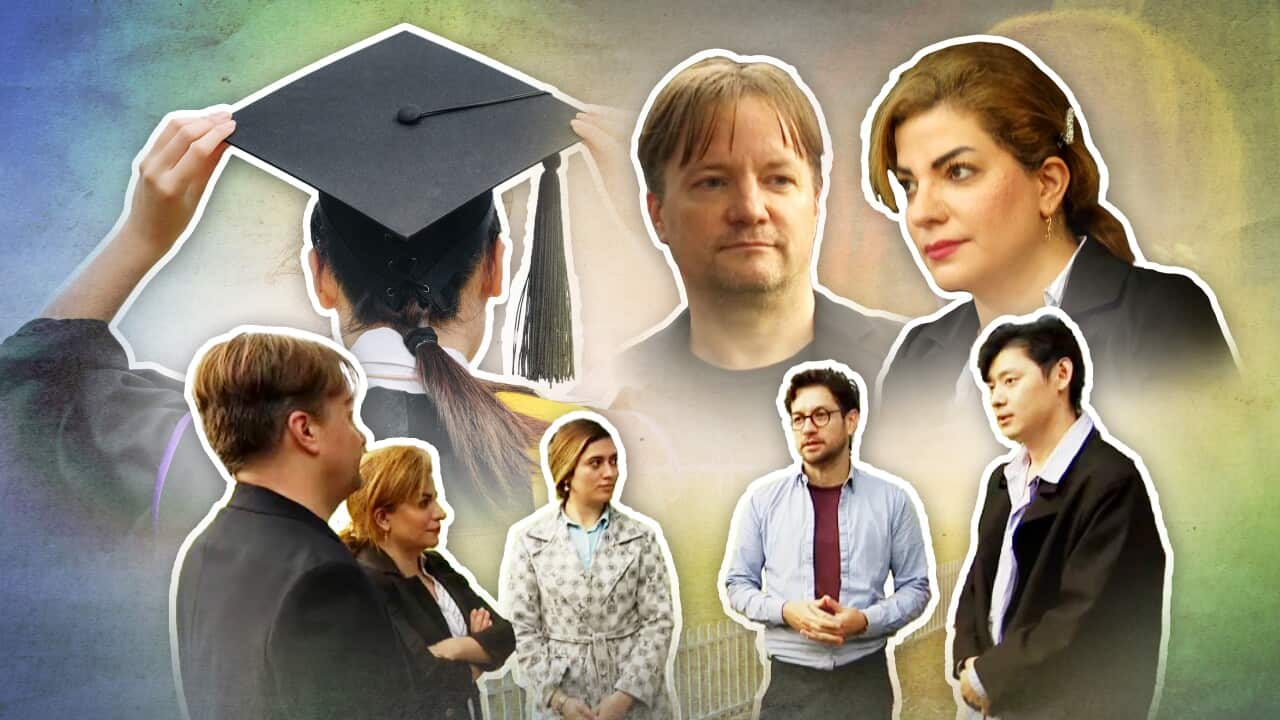There were as the government moved to stop the drivers of what it calls "permanent temporariness" among visa holders.
The long-awaited strategy followed a review of the migration system, , and also aimed to lift standards in international education, tackle exploitation and target skilled migration to the country's shortages.
For Ben Watt, a registered migration agent and lawyer, the Albanese government "said what they were going to do, and they've very much done it".
"The end of permanent temporariness is a brilliant move, and I think the changes they've made are good," he told SBS News.
'Permanent temporariness' refers to long-term temporary stays, often driven by 'visa hopping' — where people stay in the country for years by shifting between visa types.
While Watt thinks the reforms are broadly positive, he argues some will work to "fine tune" the system instead of resulting in major change.
"At the end of the day, with all this discussion ... the amount of permanent visas is staying about the same," he said.
Abul Rizvi, a former deputy secretary at the Department of Immigration from the early 1990s to 2007, agreed this is a concern.
What major visa changes were announced in 2024?
The government has allocated 185,000 places to the permanent migration program for 2024-25, down from 190,000 in the previous financial year.
It has allocated 132,200 places (around 71 per cent) to skilled migrants (down from 137,100 in 2023-24), including 44,000 employer-sponsored visas (up slightly from 36,825); 16,900 skilled independent visas (almost halved from 30,375); 33,000 regional (similar to 32,300) and 33,000 state and territory nominated visas (up slightly from 30,400).
A combined 5,000 visas were allocated to Business Innovation and Investment and Global Talent visa streams (down from 6,900). The former program closed in July and the latter was replaced with a new National Innovation visa.
Many of the announced changes came into effect on 1 July 2024, with reforms to the skilled visa program being unveiled in December.
Student visas
Late last year, . However, the Opposition blocked the plan, prompting the government to abandon it.
In response, the government has now introduced a new way to manage the number of international students coming into Australia.
The new ministerial direction 111 will introduce two categories of student visa processing: "high priority" and "standard priority" instead of capping numbers.
All international education providers will receive high priority up to 80 per cent of their indicative international student allotment received this year. After 80 per cent, they will receive standard priority.
Announcing the change, Minister for Home Affairs Tony Burke said: "The best option would have been the cap that was voted down by Peter Dutton, but this option will still allow us to use one of the biggest levers in our migration system."
The new scheme will replace ministerial direction 107, which was introduced by the government last year to reduce student numbers in the short term by slowing down visa processing for smaller universities and students from countries deemed more likely to breach visa rules.
There were several other changes to the student visa program.
This included eligibility reforms, with restrictions introduced barring certain temporary visa holders from applying for a student visa.
From 1 July last year, temporary graduate, visitor and maritime crew visa holders were unable to apply while in Australia. The full list is available on the .
"Visa hopping has contributed to a growing cohort of 'permanently temporary' former international students living in Australia," the department said at the time.
"These changes, combined with other measures, will help to close this loophole and put an end to this practice."
Also from 1 July, the fee for international student visas increased from $710 to $1,600.
The financial capacity requirement — or the amount that student and student guardian visa applicants need to have to be eligible — rose from May 2024, aligned with a proportion (75 per cent) of the national minimum wage. New English language requirements also came into effect in March.
Rizvi said a lot of the student visa policy changes "needed to be done".
While many of these impacted application rates, he said the biggest impact came from the
Temporary Graduate visas
Under changes which came into effect on 1 July, the length of stay for Temporary Graduate visa (TGV) holders was reduced,
The Temporary Graduate Visa (subclass 458) was streamlined from four streams into three: Post-Vocational Education Work, Post-Higher Education and Second Post-Higher Education Work.
The age limit was reduced to 35 years of age or under. Those undertaking a master's degree or a doctorate (PhD) are still eligible until the age of 50.
Hong Kong and British National Overseas passport holders are also still eligible until age 50.
The length of stay doesn't change for holders of a TGV in the Post-Vocational Education Work stream, which remains up to 18 months.
But for those in the Post-Higher Education Work stream, the length of stay changes: individuals completing a bachelor's degree, including honours, can stay up to two years. For a master's degree by coursework, the maximum stay will be up to two years, and for students studying for a master's degree by research or a PhD, three years.
Skills in Demand visa
Watt said one of the biggest changes in 2024 related to employer-sponsored visas, which have been "expanded and improved" with the introduction of a Skills in Demand (SID) visa.
The new visa replaced the Temporary Skills Shortage (TSS, subclass 482) visa, and allows an employer to sponsor an eligible worker to fill a position where they can't find an appropriately skilled Australian worker.
Two streams of the SID took effect on 7 December.
Those who are eligible can stay in Australia on the visa for up to four years, while Hong Kong passport holders may stay up to five years.
The visa has three targeted streams: Core Skills, focusing on areas with shortages; Specialist Skills, for high-earning and highly-skilled migrants; and an existing stream for those nominated to work in a specified job under the teams of a labour agreement.
Under the core skills stream, eligible holders must be sponsored to work in an occupation listed on the government's updated Core Skills Occupation List (CSOL),
They must meet the proposed Core Skills Income Threshold (CSIT), aligned with the Temporary Skilled Migration Income Threshold (TSMIT) which was raised to $73,150 in July.
Applicants in the specialist skills stream (in any occupation except trades, machinery operators and drivers, and labourers) must meet the Specialist Skills Income Threshold (SSIT), which sits at $135,000.
Income thresholds will be subject to annual indexation.
The existing Labour Agreement stream under the TSS visa will continue to be available under the SID visa while further development of an Essential Skills stream takes place, a Home Affairs department spokesperson told SBS News.
National Innovation Visa
Also in December, a National Innovation visa (subclass 858) replaced the Global Talent stream as a permanent visa for high-performing researchers, entrepreneurs and investors in key sectors.
Prospective applicants are required to submit an expression of interest in order to be considered and invited by the Home Affairs department.
On-hand Global Talent applications will continue to be processed in line with priorities and planning levels.
Watt said the new visa is a tightened version of the previous visa.
"In terms of the actual numbers of permanent visas that are going to be available, it's staying relatively the same."
Visa ballot process
The government has introduced a pre-application ballot process for certain kinds of visas, including those under the Working Holiday Maker program.
From 1 October 2024, ballot registrations opened for Work and Holiday (subclass 462) visa applicants from China, India and Vietnam.
The department says the process provides a "fair, streamlined and transparent way" to randomly select applicants from partner countries where demand exceeds the number of available places in a program year.
A ballot will also apply to a new temporary visa for Indian nationals, who will be able to live and work in Australia for up to two years.
Under the Mobility for Talented Early-professionals Scheme (MATES), university graduates and early career professionals from Indian universities with qualifications in areas such as renewable energy, mining, engineering and community technology are able to register.
Up to 3,000 places will be allocated under the Temporary Work (International Relations — subclass 403) visa each year. The first ballot opened for registration on 9 December.
It comes after the first ballot took place between June and August last year for a visa allowing migrants from Pacific countries and Timor Leste to live and work in Australia permanently.
The Pacific Engagement visa (PEV, subclass 192) will provide up to 3,000 permanent places each year in addition to the permanent migration program.
Laws enabling the use of a ballot for the PEV passed parliament in October 2023.
Australia's migration levels — and returning to 'normal'
The government expects its strategy will help return migration to "near pre-pandemic levels" by next financial year.
The COVID-19 pandemic prompted Australia to close its borders in 2020, and migration levels — sometimes referred to as net overseas migration or NOM — entered a shortfall.
NOM refers to the difference between those who enter and leave Australia, and includes both migrants and Australians.
With the reopening of borders in 2021-22 came the return of temporary and permanent migrants, and a subsequent temporary rebound or "catch-up" of arrivals.
"Net migration went over half a million, which is completely unprecedented in Australian history. That gave rise to a bit of panic," said Peter McDonald, a demography professor at the Australian National University.
"But if you took the four years, from 2020 to 2024, the level of migration is roughly the same as it was beforehand, on average. It was just very low in one period and very high in another." The problem came from fewer departures from Australia that year — an estimated 55,000 lower than the government's projections, according to McDonald.
After peaking in 2022-23, annual NOM dropped to 446,000 in 2023-24, according to data released by the Australian Bureau of Statistics in December.
This was about 130,000 higher than the government forecast for that year in the 2023-24 budget (315,000), and about 51,000 more than its revised projection in the 2024-25 budget of 395,000.
It was the first annual drop since the country's borders reopened. Migrant arrivals fell by 10 per cent while departures rose by 8 per cent, compared to the previous year.
Rizvi said this fall was "inevitable" given the government's tightening of policy through a "blizzard" of changes.
The government projected in last year's budget that NOM will drop to 260,000 in 2024-25.
Its Mid-Year Economic and Fiscal Outlook (MYEFO) on 18 December revised this figure up by 80,000 to 340,000. The forecast for 2025-26 held, at 255,000.
"It's still too big, but it's coming down. And as long as we don't panic, it will come down when departures start moving. With time, we'll be back to normal," McDonald had said, ahead of the MYEFO update.
A looming federal election
In his budget reply last May, Opposition leader Peter Dutton, pledged, if elected, to cut permanent migration annually by 25 per cent from 2024-25 — from 185,000 to 140,000 over two years, then back up to 160,000 over the following two years.
In interviews with radio stations 3AW and 2GB the following day, he also pledged to cut net overseas migration to about 160,000.
Speaking with Sky News on 8 December, Dutton was repeatedly asked whether 160,000 remained his NOM target. Instead, he referred to his permanent migration pledge.
"What we've said is we want our migration to step down in the first two years, it will ramp up in years three and four. And we will bring down the numbers who come through the humanitarian and refugee program back to the long run average of that," Dutton said.
"That's what will work for our country. Again, we'll have a look at our economic settings, as we said at the time of the policy announcement, when we come into the government to determine exactly how much damage Labor has done, and what we need to do." A spokesperson for Dutton said he has been on the record on numerous occasions stating the Coalition's permanent and net migration figures. "I don't think he could be accused of shying away from that," they said.
What other changes could happen in 2025?
When the government announced its plan to cap the number of international student enrolments in 2024, it was said that the measure would place the sector on a more sustainable footing.
It raised concerns among some education providers.
A Senate report recommended the legislation , however, the government changed course after facing strong opposition from the Coalition and the Greens.
Elaborating on ministerial direction 111 that embodies this change, Education Minister Jason Clare said: "Improving the current approach will strengthen our ability to manage the flow of international students and better support regional education providers."
"It shouldn't just be the big inner-city unis that benefit from international education. TAFEs, regional and suburban unis should benefit too, and this new approach will help us do that."
Rizvi argues this faces a broader issue.
"What happens to all those temporary graduates and students who are looking for a pathway to permanent residence but won't get one because there are not enough places? That's really difficult."
Looking ahead to this year, Watt said: "We'll see what happens. I want it to go well."








